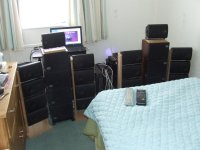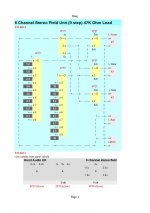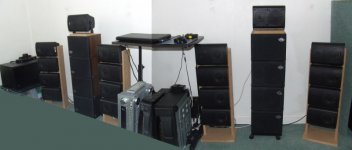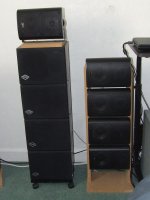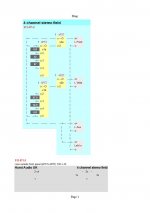Yes, life does seem to get in the way. I hope that you will be able to do some testing with matching speakers. It would be good to have input from someone who has actually heard a working system, particularly someone with experience of "Big" sounding systems. I'm a novice in that respect....further tries will have to wait until autumn or winter. 🙁
Talking of space constraints, there are 26 speakers in the attached photo, that you can see, and a further 12 you can't see! At least the bed is comfortable.Thanks for an interesting read. It's not something I could try due to space constraints in my living room.
No thanks, but thanks for the thought. Shouldn't that be "INsane amount of speakers"? 😉As a further twist how about turning the stacks bipolar with the sane amount of speakers facing backwards? A bit of BSC for free.
Attachments
I can quickly throw together a 6 speaker system where I am now, but again it would be 3 different pairs. Might give it a try for the heck of it. What surprised me about my first try is that it didn't kill the stereo image, collapse it or make it into a uniform block. Left to Right was well preserved.
Six identical speakers ought to be much better. I hope to test it sooner or later.
Six identical speakers ought to be much better. I hope to test it sooner or later.
There is still little understood and much to be improved in stereo reproduction.
This pretty much says it all, from 1935, unless you want to alter the information that is on the stereo recording.
Espacenet – search results
I don't see a schematic of the Stereo Field Unit circuit, just assembly instructions. Is there a schematic?
You use the acoustic time delay from the more distant, wide field speakers for added spaciousness?
Last edited:
@rayma
The schematics are embedded in spreadsheets, which allow me to "tweak" the design. So it may take me a few days to get one into text or pdf form.
The schematics are embedded in spreadsheets, which allow me to "tweak" the design. So it may take me a few days to get one into text or pdf form.
Last edited:
There is a theoretical underpinning of the design, but it is incomplete, and contradictory. I touched on it way back in #36. However, I will try and give a fuller expo...There is still little understood and much to be improved in stereo reproduction.
@rayma
The schematics are embedded in spreadsheets, which allow me to "tweak" the design.
So it may take me a few days to get one into text or pdf form.
It's a resistive summing matrix? I think people would want to understand it before building it.
That could take some time. I'm considering whether just talking you through it would be quicker? Anyway, here goes...
This description is in a logical order. It does not match the order of the actual circuit. The drawing of the facia gives you the logic elements:
1. A 6P2T switch switches between 2 channel and 6 channel mode.
2. In two channel mode a 2P3T switch switches the output between the three pairs of outputs: Front (1x), Wide (3x) and Side (5x). This is used to:
a) Provide an A:B comparison between 6 channel and ordinary stereo (1x).
b) Indicate the widest setting that is useful (3x).
c) Check that the system is wired correctly.
3. In six channel mode you can vary the setting of the width of the stereo field from 1x (stereo) to 3x the speaker to speaker (or stack to stack) distance, in 1/4 width settings.
I hope that helps...
This description is in a logical order. It does not match the order of the actual circuit. The drawing of the facia gives you the logic elements:
1. A 6P2T switch switches between 2 channel and 6 channel mode.
2. In two channel mode a 2P3T switch switches the output between the three pairs of outputs: Front (1x), Wide (3x) and Side (5x). This is used to:
a) Provide an A:B comparison between 6 channel and ordinary stereo (1x).
b) Indicate the widest setting that is useful (3x).
c) Check that the system is wired correctly.
3. In six channel mode you can vary the setting of the width of the stereo field from 1x (stereo) to 3x the speaker to speaker (or stack to stack) distance, in 1/4 width settings.
I hope that helps...
Last edited:
I should add, that the black blobs in the circuit diagram are K ohm resistors. The values given assume that the input impedance of the power amp (the load) is 47K ohms. The resistances may be scaled up/down to suit other loads...
Would four matching speakers be more achievable? Four speakers can double the width of the stereo field (for a given speaker-to-speaker distance), or allow the speaker-to-speaker distance to be halved for a given width of the stereo field.I can quickly throw together a 6 speaker system where I am now, but again it would be 3 different pairs. Might give it a try for the heck of it. What surprised me about my first try is that it didn't kill the stereo image, collapse it or make it into a uniform block. Left to Right was well preserved.
I have rearranged my listening room to place the speakers against the longer wall and I've finally had a chance to listen to the MSX-07's. What a surprise. Compared to a pair of MSX-07's the four stacks have powerfull presence and authority, Of course, I have no idea how the stacks would compare to "real" power systems, but at only 75cm (30 inches) tall they impress me!
Attachments
That looks like a whole lot of speaker! I'm sure it does sound authoritative. Just doing 3 pair of small speakers in my garage meant much more authority and "meat" to the sound.
There are actually three speaker rigs in the picture:
- 2 of Ariston MSX-07 (single) speakers.
- 2 of Wharfedale Diamond (x4) stacks.
- 4 of Ariston MSX-07 (x4) stacks.
The two big stacks are Wharfedale Diamond 1's, with individual MSX-07's perched on top. The four diminuitive stacks are MSX-07's.
- 2 of Ariston MSX-07 (single) speakers.
- 2 of Wharfedale Diamond (x4) stacks.
- 4 of Ariston MSX-07 (x4) stacks.
The two big stacks are Wharfedale Diamond 1's, with individual MSX-07's perched on top. The four diminuitive stacks are MSX-07's.
- Home
- Loudspeakers
- Multi-Way
- Multi-Speaker Reproduction Of Conventional Stereo Recordings
